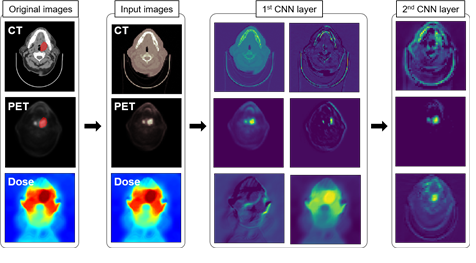글로벌 연구동향
방사선종양학
- 2022년 04월호
[J Pers Med.] Locoregional Recurrence Prediction Using a Deep Neural Network of Radiological and Radiotherapy Images가톨릭의대 / 한규민, 성원모*, 강영남*
- 출처
- J Pers Med.
- 등재일
- 2022 Jan 21
- 저널이슈번호
- 12(2):143. doi: 10.3390/jpm12020143.
- 내용
Abstract
Radiation therapy (RT) is an important and potentially curative modality for head and neck squamous cell carcinoma (HNSCC). Locoregional recurrence (LR) of HNSCC after RT is ranging from 15% to 50% depending on the primary site and stage. In addition, the 5-year survival rate of patients with LR is low. To classify high-risk patients who might develop LR, a deep learning model for predicting LR needs to be established. In this work, 157 patients with HNSCC who underwent RT were analyzed. Based on the National Cancer Institute's multi-institutional TCIA data set containing FDG-PET/CT/dose, a 3D deep learning model was proposed to predict LR without time-consuming segmentation or feature extraction. Our model achieved an averaged area under the curve (AUC) of 0.856. Adding clinical factors into the model improved the AUC to an average of 0.892 with the highest AUC of up to 0.974. The 3D deep learning model could perform individualized risk quantification of LR in patients with HNSCC without time-consuming tumor segmentation.
AffiliationsKyumin Han 1 2 , Joonyoung Francis Joung 3 , Minhi Han 3 , Wonmo Sung 1 4 , Young-Nam Kang 2 5
1Department of Biomedicine & Health Sciences, College of Medicine, The Catholic University of Korea, Seoul 06591, Korea.
2Advanced Institute for Radiation Fusion Medical Technology, College of Medicine, The Catholic University of Korea, Seoul 06591, Korea.
3Department of Chemistry and Research, Institute for Natural Science, Korea University, Seoul 02841, Korea.
4Department of Biomedical Engineering, College of Medicine, The Catholic University of Korea, Seoul 06591, Korea.
5Department of Radiation Oncology, Seoul St. Mary's Hospital, College of Medicine, The Catholic University of Korea, Seoul 06591, Korea.
- 키워드
- deep learning; head and neck squamous cell carcinoma; locoregional recurrence.
- 연구소개
- 국소재발이 발생한 두경부편평세포암(Head and neck squamous cell carcinoma:HNSCC) 환자의 5년 생존율이 50%를 넘지 않아 국소재발에 대한 예측의 필요성이 요구되어지고 있는 상황입니다. 최근 HNSCC의 국소재발을 예측하기 위한 많은 연구에서 radiomics 방법이 방사선 치료 후의 예후를 예측할 수 있음이 입증되고 있습니다. Radiomics와 유사한 방법으로 선량분포를 이용한 dosiomics는 예측성능을 한층 더 향상시키는 것으로 보고되고 있습니다. 방사선 의료 영상은 비침습적이며 종양의 이질성을 반영할 수 있지만 기존 radiomics 방법에서는 종양 및 장기의 분할이 필요합니다. 그러나 종양 및 장기의 분할은 국소재발을 예측하는데 있어서 예기치 않은 재현성등의 문제가 발생할 수 있습니다. 본 연구에서는 이러한 문제를 해결하기 위해 분할 과정 없이 CT, FDG-PET, 선량 분포를 활용하여 HNSCC 환자의 국소재발을 예측하는 3D CNN(Convolutional Neural Network) 모델을 제안했습니다. 이 연구에서 우리는 3D CNN 모델이 분할 과정 없이 의료 영상에서 국소재발 관련 특징을 효과적으로 포착할 수 있음을 발견했습니다. 본 연구는 HNSCC 환자 중 방사선치료 후 국소재발 예측을 위한 모델을 개발한것으로서 아직은 임상적 요인들이 더 추가가 되어야 하는 초기단계이긴하나 radiomics와 dosiomics의 장점들을 융합한 모델로서 의의가 있으며 추후 완성도를 향상시켜 간암의 예후에 대해서도 진행할 예정입니다. 모델의 완성도를 향상시킨다면 방사선치료계획시 국소재발 확률을 낮출 수 있는 조건을 제시하는 지원시스템으로서 역할이 가능할것으로 기대합니다.
- 덧글달기







